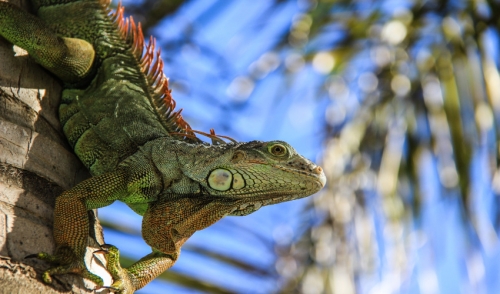From turtles and tortoises to snakes, geckos and iguanas, reptiles can be great pets, even for kids. Unfortunately, many children are squeamish around reptiles or even afraid of them. With patience and understanding, however, you can teach your child to be comfortable around all types of popular pet reptiles.
Why Kids Can Be Uncomfortable
Understanding why a child doesn't like pet reptiles is the first step toward helping them feel better about these animals. Unfortunately, many reptiles that young children are first exposed to are often portrayed as monsters, such as vicious dinosaurs, dragons or supervillains. The size, speed and fictional abilities of these creatures – breathing fire, flying, spitting acid, etc. – can make them even more frightening. Young children may not understand the differences between real-life lizards and Hollywood's monsters, and their fear can spread to all types of reptiles they don't recognize or understand.
Easy Ways to Help Your Child Be Comfortable Around Pet Reptiles
There are several steps parents can take to help their child be more at ease around pet reptiles.
- Visit a Nature Center
Many nature centers have kid-friendly events where children can meet different reptiles in safe, easy-going ways. Getting up close to the reptiles and learning more about them can help children see how useful these creatures can be and why they're an important part of our ecosystems. That personal exposure can help kids overcome some of their fear when they discover real life reptiles aren't as bad as they imagined.
- Learn About Real Reptiles
A visit to the local library can help children learn just how fun and fascinating reptiles can be. Look for age-appropriate books about snakes, lizards and turtles, and help children research these animals so they can better appreciate all creatures, even ones that may seem scary. Very young children may also benefit from picture books that show cartoon reptiles as positive role models rather than bad characters.
- Talk About Movies and Fiction
If children are frightened by movie monsters, watching outtakes and behind-the-scenes footage can help them learn just how those monsters are created and why they're nothing like any real reptiles. Discussing the difference between the entertainment of movies and books and the reality of the natural world can help children learn to be more comfortable around reptiles.
- Provide a Positive Example
Many times when children are frightened of something, it is because they are mimicking an adult's behavior. If parents are scared of snakes or squeamish around lizards, the children will naturally develop similar phobias. Conquering those fears can help pass on a more balanced, positive perspective to the next generation.
- Start Small
If a child is frightened of large snakes, it will not be helpful to bring home a mature python for a pet. Instead, start very small, with different reptiles the child can get accustomed to at their own pace. This will help desensitize the child to their fears as they learn to be more comfortable around all sorts of reptiles.
- Teach Proper Reptile Care and Handling
When introducing children to pet reptiles, it is essential to each responsible pet care and reptile handling techniques. This will reduce the risk of any inadvertent bites or aggressive behaviors that could frighten a child even more. As they get more accustomed to these pets, their fears and insecurities will diminish.
- Never Force a Friendship
In some cases, children may simply be too frightened or nervous to easily get comfortable with pet reptiles. It is important to never force a child into a situation where they are scared, as their nervousness will make the reptile more unpredictable as well. Instead, let them proceed at their own pace with adult supervision and support.
Despite all the best intentions, there may be times when a child continues to have strong fears, even phobias, about pet reptiles. When these reactions are severe, it may be necessary to seek professional guidance from a doctor, counselor or child psychologist to be sure there are no underlying emotional issues or other problems contributing to the child's discomfort. In time, most children will be able to adapt to pet reptiles, and will develop a new appreciation for these amazing creatures and the roles they play in our world and our lives.


Comments